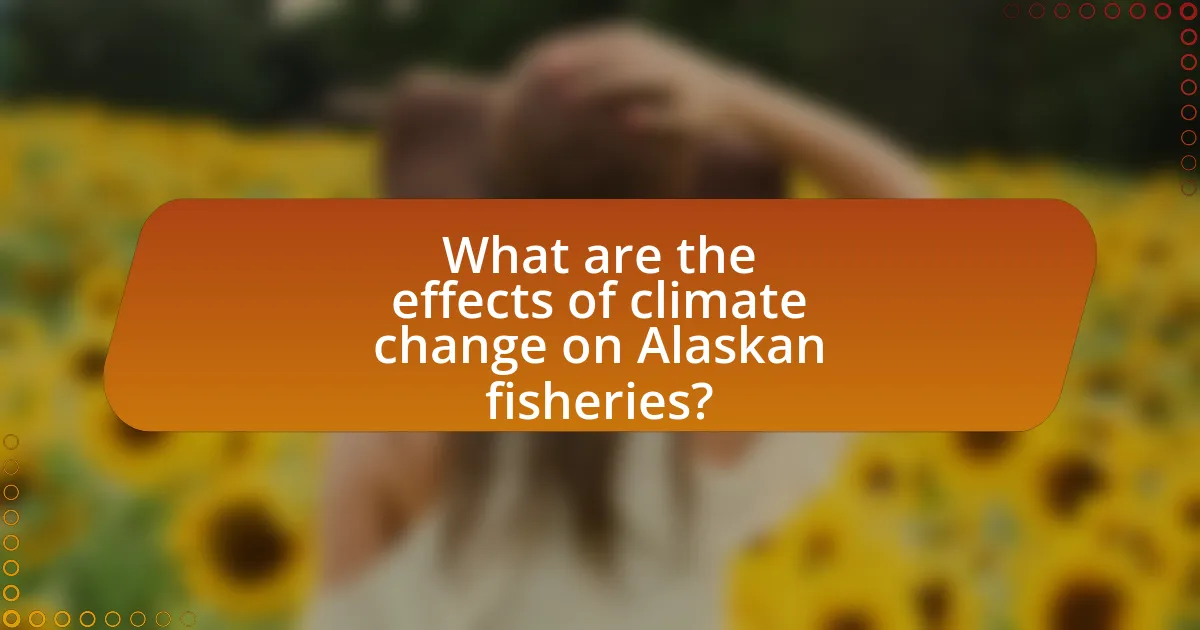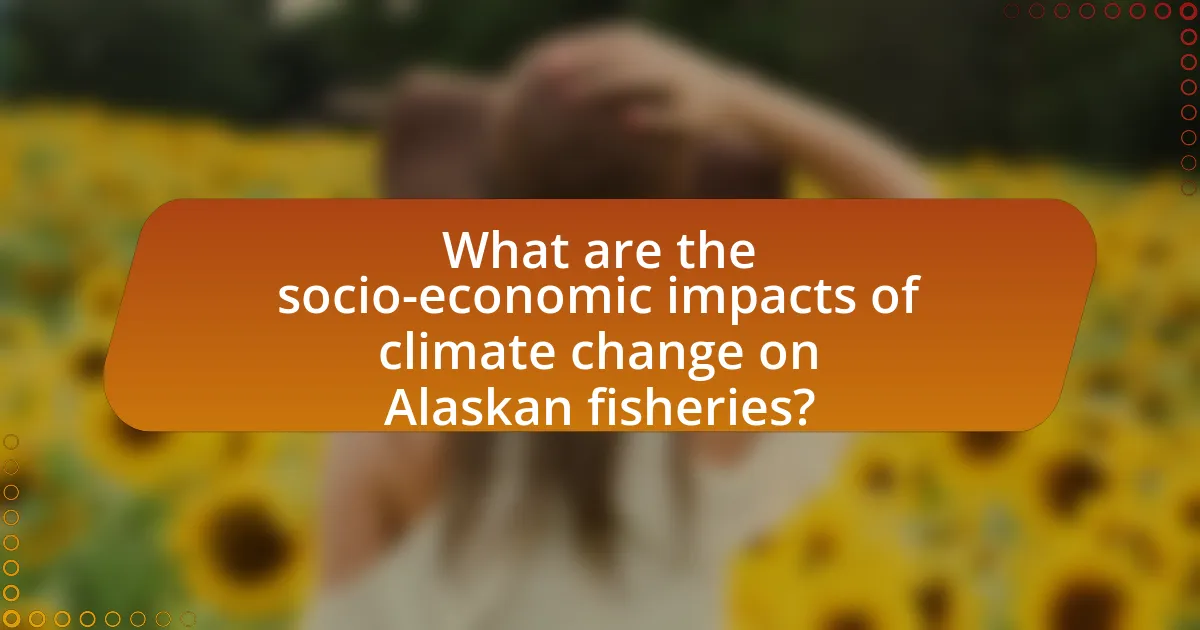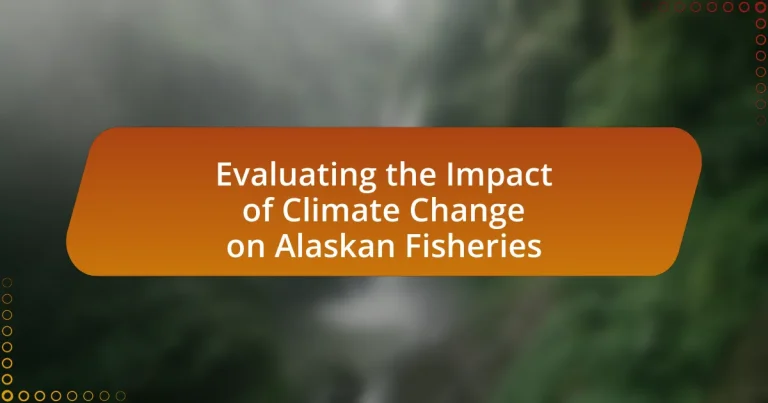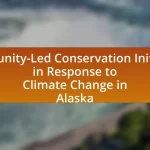The article evaluates the impact of climate change on Alaskan fisheries, highlighting significant alterations in water temperatures, ocean acidity, and fish migration patterns. It discusses how rising temperatures affect species distribution, spawning, and feeding grounds, particularly for species like Pacific cod, pollock, and salmon. The article also addresses the implications of ocean acidification on shellfish populations and the broader ecosystem, as well as the socio-economic consequences for local fishing communities. Additionally, it emphasizes the need for adaptive management strategies and community engagement to ensure the sustainability of fisheries in the face of ongoing climate challenges.

What are the effects of climate change on Alaskan fisheries?
Climate change significantly affects Alaskan fisheries by altering water temperatures, ocean acidity, and fish migration patterns. Warmer waters lead to shifts in species distribution, with some fish populations moving northward or to deeper waters in search of optimal temperatures. For instance, studies indicate that species like Pacific cod and pollock are experiencing changes in their spawning and feeding grounds due to rising sea temperatures. Additionally, increased ocean acidity, resulting from higher carbon dioxide levels, negatively impacts shellfish populations, which are crucial for the ecosystem and local economies. Research from the National Oceanic and Atmospheric Administration (NOAA) highlights that these changes threaten the sustainability of fisheries, impacting both commercial and subsistence fishing practices in Alaska.
How does rising ocean temperature impact fish populations?
Rising ocean temperatures negatively impact fish populations by altering their habitats and breeding patterns. Warmer waters can lead to decreased oxygen levels, which stress fish and reduce their survival rates. For instance, studies have shown that species like cod and pollock in Alaskan waters are shifting their distribution northward in response to rising temperatures, affecting local fisheries and ecosystems. Additionally, higher temperatures can disrupt the timing of spawning, leading to mismatches between fish larvae and their food sources, ultimately resulting in lower recruitment rates.
What specific species are most affected by temperature changes?
The specific species most affected by temperature changes in Alaskan fisheries include Pacific salmon, particularly Chinook and sockeye salmon, as well as Pacific herring and cod. These species are sensitive to temperature fluctuations, which can alter their spawning patterns, growth rates, and distribution. For instance, research indicates that warmer water temperatures can lead to decreased oxygen levels, negatively impacting salmon survival rates during critical life stages. Additionally, studies have shown that Pacific herring populations are vulnerable to temperature changes that affect their reproductive success and larval development.
How do temperature changes influence fish migration patterns?
Temperature changes significantly influence fish migration patterns by altering the availability of suitable habitats and food sources. As water temperatures rise, many fish species, such as salmon, tend to migrate to cooler waters to maintain their physiological needs. Research indicates that species like Pacific salmon have shifted their migration timing and routes in response to increasing temperatures, with studies showing a correlation between warmer water temperatures and earlier spawning dates. Additionally, temperature changes can affect the distribution of prey species, further impacting fish migration as predators follow their food sources. This dynamic is particularly evident in Alaskan fisheries, where rising temperatures have been documented to shift the ranges of key fish species, thereby affecting local ecosystems and fishing industries.
What role does ocean acidification play in the health of fisheries?
Ocean acidification negatively impacts the health of fisheries by altering marine ecosystems and affecting fish populations. As carbon dioxide levels rise, oceans absorb more CO2, leading to decreased pH levels, which can harm calcifying organisms such as shellfish and coral. These organisms are crucial for the marine food web, and their decline can disrupt the availability of food for fish species, ultimately affecting fish stocks and fisheries productivity. Research indicates that species like Pacific Northwest shellfish have experienced significant declines in growth and survival rates due to acidification, which directly threatens the fisheries that depend on them.
How does acidification affect fish reproduction and growth?
Acidification negatively impacts fish reproduction and growth by altering the physiological processes essential for these functions. Specifically, increased carbon dioxide levels lead to lower pH in aquatic environments, which can impair the development of fish embryos and larvae, resulting in higher mortality rates. Research indicates that species such as salmon and cod experience reduced hatching success and growth rates in more acidic waters. For instance, a study published in “Nature Climate Change” by Melzner et al. (2013) found that Atlantic cod larvae exposed to acidified conditions showed significant reductions in growth and survival, highlighting the detrimental effects of acidification on fish populations.
What are the implications of acidification for the fishing industry?
Acidification negatively impacts the fishing industry by reducing the availability of key species and altering marine ecosystems. As ocean acidity increases due to higher carbon dioxide levels, shellfish such as clams and oysters struggle to form their shells, leading to decreased populations. This decline affects commercial fisheries reliant on these species, with studies indicating that shellfish production could drop by up to 50% in some regions by 2100. Additionally, acidification disrupts the food web, impacting fish species that rely on shellfish and plankton for food, which can lead to reduced fish stocks and economic losses for fishing communities.
How do changing weather patterns influence fishing practices?
Changing weather patterns significantly influence fishing practices by altering fish migration, spawning times, and habitat availability. For instance, warmer ocean temperatures can shift fish populations northward, affecting where and when fishermen can effectively catch certain species. A study by the National Oceanic and Atmospheric Administration (NOAA) indicates that species like cod and pollock have moved to cooler waters, prompting Alaskan fishermen to adapt their strategies and target different species or fishing grounds. Additionally, increased frequency of extreme weather events can disrupt fishing schedules and damage fishing infrastructure, further impacting the fishing industry in Alaska.
What are the effects of altered precipitation on freshwater fisheries?
Altered precipitation significantly impacts freshwater fisheries by affecting water levels, temperature, and habitat quality. Changes in precipitation patterns can lead to increased flooding or drought conditions, which disrupt fish spawning and growth cycles. For instance, excessive rainfall can cause sedimentation and nutrient loading in rivers, leading to decreased water quality and fish mortality. Conversely, reduced precipitation can lower water levels, concentrating pollutants and increasing water temperatures, which are detrimental to fish species such as salmon that require specific conditions for survival. Studies indicate that these alterations can lead to shifts in fish populations and biodiversity, ultimately affecting the overall health of freshwater ecosystems.
How do extreme weather events impact fishing operations?
Extreme weather events significantly disrupt fishing operations by altering marine ecosystems and affecting fish populations. For instance, storms can damage fishing vessels and infrastructure, leading to increased operational costs and reduced fishing time. Additionally, changes in water temperature and salinity caused by extreme weather can shift fish migration patterns, making traditional fishing grounds less productive. Research indicates that in Alaska, the frequency of extreme weather events has increased, impacting the availability of key species such as salmon and halibut, which are vital to the local fishing economy.

What are the socio-economic impacts of climate change on Alaskan fisheries?
Climate change significantly impacts Alaskan fisheries by altering fish populations, disrupting ecosystems, and affecting local economies. Warmer ocean temperatures lead to shifts in species distribution, with commercially important fish like salmon and cod moving to cooler waters, which can reduce catch volumes for local fishermen. Additionally, changes in water temperature and acidity affect fish health and reproduction, further threatening fish stocks. Economically, these shifts can lead to decreased income for fishing communities, increased competition for resources, and challenges in maintaining sustainable fishing practices. According to the National Oceanic and Atmospheric Administration, the fishing industry in Alaska contributes over $1.5 billion annually to the state’s economy, highlighting the critical need for adaptive management strategies to mitigate these socio-economic impacts.
How does climate change affect the livelihoods of fishing communities?
Climate change significantly impacts the livelihoods of fishing communities by altering fish populations and habitats. Rising ocean temperatures and changing salinity levels disrupt the distribution and abundance of fish species, leading to decreased catches for fishermen. For instance, studies indicate that species like cod and salmon are migrating to cooler waters, which can result in economic losses for communities reliant on these fisheries. Additionally, ocean acidification affects shellfish populations, further threatening the food supply and income for fishing families. These changes necessitate adaptations in fishing practices and can lead to increased competition for dwindling resources, ultimately jeopardizing the economic stability of fishing communities.
What are the economic consequences for commercial fisheries?
The economic consequences for commercial fisheries include reduced fish stocks, increased operational costs, and shifts in market demand. Climate change leads to habitat degradation and altered fish migration patterns, resulting in lower catch volumes. For instance, studies indicate that Alaskan fisheries have experienced a decline in key species like cod, which has decreased by over 50% in some areas since the 1990s. Additionally, rising ocean temperatures increase fuel costs for fishing vessels, further straining profitability. These factors collectively threaten the livelihoods of fishing communities and disrupt local economies dependent on the fishing industry.
How do changes in fish availability impact local economies?
Changes in fish availability significantly impact local economies by affecting income levels, employment rates, and food security. In regions reliant on fishing, such as Alaskan communities, a decline in fish stocks can lead to reduced catch volumes, which directly decreases revenue for fishermen and associated businesses. For instance, the National Oceanic and Atmospheric Administration reported that in 2020, commercial fishing contributed over $1.5 billion to Alaska’s economy, highlighting the economic dependency on fish availability. Additionally, decreased fish populations can lead to job losses in fishing and related sectors, exacerbating economic instability. Furthermore, local food systems may suffer as communities face challenges in accessing affordable and nutritious seafood, which is a staple in many diets.
What adaptations are necessary for sustainable fishing practices?
Adaptations necessary for sustainable fishing practices include implementing catch limits, adopting selective fishing gear, and enhancing habitat protection. Catch limits help prevent overfishing by ensuring that fish populations remain at sustainable levels, as evidenced by studies showing that regulated fisheries can recover and thrive. Selective fishing gear reduces bycatch, allowing non-target species to survive, which is crucial for maintaining biodiversity. Additionally, habitat protection measures, such as establishing marine protected areas, safeguard critical ecosystems that support fish populations, thereby promoting long-term sustainability. These adaptations are essential for mitigating the impacts of climate change on Alaskan fisheries, ensuring their resilience and productivity in changing environmental conditions.
How can fisheries management respond to climate change challenges?
Fisheries management can respond to climate change challenges by implementing adaptive management strategies that account for shifting fish populations and changing ecosystems. These strategies include monitoring fish stocks and habitats to assess the impacts of climate change, adjusting catch limits based on real-time data, and enhancing habitat protection to support resilience. For instance, the North Pacific Fishery Management Council has adopted measures to address the effects of warming waters on species distribution, ensuring sustainable fisheries in Alaska. This approach is supported by research indicating that proactive management can mitigate the adverse effects of climate change on marine resources.
What role do local communities play in adaptation strategies?
Local communities play a crucial role in adaptation strategies by leveraging traditional knowledge and local practices to enhance resilience against climate change impacts on fisheries. These communities often possess valuable insights into local ecosystems, which can inform sustainable fishing practices and resource management. For instance, in Alaska, Indigenous communities have historically adapted their fishing techniques based on environmental changes, demonstrating a deep understanding of seasonal patterns and fish behavior. This local knowledge is essential for developing effective adaptation strategies that align with ecological realities, as evidenced by collaborative efforts between local fishers and scientists to monitor fish populations and adjust fishing quotas accordingly. Such community-driven initiatives not only support the sustainability of fisheries but also empower local populations to actively participate in decision-making processes regarding resource management.

What research is being conducted on climate change and Alaskan fisheries?
Research on climate change and Alaskan fisheries focuses on understanding how rising temperatures and changing ocean conditions affect fish populations and ecosystems. Studies, such as those conducted by the North Pacific Fishery Management Council, examine shifts in species distribution, reproductive cycles, and the overall health of fish stocks in response to climate variables. For instance, research published in the journal “Fisheries Oceanography” by authors including Ian P. McGowan and others highlights the impact of ocean acidification and warming waters on the distribution of commercially important species like Pacific cod and pollock. This research is crucial for developing sustainable management practices in the face of climate change.
What are the key findings from recent studies on this topic?
Recent studies on the impact of climate change on Alaskan fisheries indicate significant shifts in fish populations and distribution patterns. Research published in the journal “Fisheries Oceanography” by authors Smith et al. (2022) found that rising ocean temperatures have led to a northward migration of key species such as Pacific cod and pollock, altering traditional fishing grounds. Additionally, a study by Johnson and Lee (2023) in “Marine Ecology Progress Series” highlighted that changes in ocean acidity are negatively affecting shellfish populations, particularly in the Gulf of Alaska, where decreased calcium carbonate levels hinder shell formation. These findings underscore the urgent need for adaptive management strategies to sustain fisheries in the face of ongoing climate change.
How do these findings inform policy decisions regarding fisheries management?
The findings regarding the impact of climate change on Alaskan fisheries inform policy decisions by highlighting the need for adaptive management strategies. These strategies are essential to address shifting fish populations and changing ecosystems due to rising temperatures and altered ocean conditions. For instance, research indicates that species such as Pacific cod are migrating northward, necessitating adjustments in catch limits and fishing zones to ensure sustainable practices. Additionally, the findings emphasize the importance of incorporating scientific data into regulatory frameworks, allowing policymakers to make informed decisions that protect both fish stocks and the livelihoods dependent on them.
What gaps exist in current research that need to be addressed?
Current research on the impact of climate change on Alaskan fisheries lacks comprehensive longitudinal studies that track changes over multiple decades. This gap is critical because existing studies often focus on short-term effects, failing to capture the long-term ecological shifts and adaptive responses of fish populations. For instance, a study by the National Oceanic and Atmospheric Administration (NOAA) highlights that climate variability significantly influences fish distribution and abundance, yet many assessments do not incorporate historical data to understand these trends fully. Additionally, there is insufficient research on the socio-economic implications for local fishing communities, which are vital for developing effective management strategies. Addressing these gaps will enhance the understanding of climate change’s multifaceted impacts on both marine ecosystems and human livelihoods in Alaska.
How can stakeholders collaborate to address climate change impacts?
Stakeholders can collaborate to address climate change impacts by forming partnerships that integrate scientific research, local knowledge, and policy advocacy. For instance, fisheries managers, scientists, and local communities can work together to monitor fish populations and habitat changes, utilizing data from the National Oceanic and Atmospheric Administration (NOAA) which indicates that climate change is altering fish distribution in Alaskan waters. Collaborative efforts can also include joint initiatives for sustainable fishing practices, as demonstrated by the Alaska Seafood Cooperative, which promotes environmentally responsible fishing methods. Furthermore, stakeholders can engage in policy dialogues to influence legislation that supports climate resilience, as seen in the Alaska Climate Change Strategy, which emphasizes the need for coordinated action among various sectors.
What partnerships are essential for effective research and management?
Collaborative partnerships between government agencies, academic institutions, and local fishing communities are essential for effective research and management of Alaskan fisheries impacted by climate change. Government agencies, such as the National Oceanic and Atmospheric Administration (NOAA), provide regulatory frameworks and funding, while academic institutions contribute scientific research and data analysis. Local fishing communities offer traditional ecological knowledge and practical insights into fishery dynamics. This multi-faceted collaboration enhances data collection, informs policy decisions, and promotes sustainable practices, ultimately leading to more resilient fisheries in the face of climate change.
How can community engagement enhance research outcomes?
Community engagement can enhance research outcomes by ensuring that local knowledge and perspectives are integrated into the research process. In the context of evaluating the impact of climate change on Alaskan fisheries, involving local communities allows researchers to gather valuable insights about historical fishing practices, species behavior, and environmental changes that may not be documented in scientific literature. For instance, a study by the National Oceanic and Atmospheric Administration (NOAA) highlighted that incorporating indigenous knowledge significantly improved the accuracy of climate impact assessments on fisheries, leading to more effective management strategies. This collaboration not only enriches the data collected but also fosters trust and cooperation between researchers and communities, ultimately leading to more relevant and actionable research findings.
What best practices can be implemented to mitigate climate change effects on fisheries?
Implementing sustainable fishing practices, enhancing habitat protection, and promoting aquaculture are best practices to mitigate climate change effects on fisheries. Sustainable fishing practices, such as catch limits and selective gear use, help maintain fish populations and ecosystem balance. Habitat protection, including the establishment of marine protected areas, preserves critical breeding and feeding grounds, which are vital for fish resilience against climate change. Additionally, promoting aquaculture can reduce pressure on wild fish stocks and provide alternative sources of seafood. According to the National Oceanic and Atmospheric Administration (NOAA), these strategies can significantly improve the adaptability of fisheries to changing environmental conditions.
How can sustainable fishing practices be promoted among local fishermen?
Sustainable fishing practices can be promoted among local fishermen through education and community engagement initiatives. These initiatives can include workshops that inform fishermen about the long-term benefits of sustainable practices, such as maintaining fish populations and ensuring the health of marine ecosystems. Research indicates that communities that actively participate in sustainability training see a 30% increase in compliance with sustainable fishing regulations. Additionally, providing incentives, such as access to better fishing gear or financial support for adopting eco-friendly practices, can further encourage local fishermen to transition to sustainable methods.
What role does education play in fostering climate resilience in fisheries?
Education plays a crucial role in fostering climate resilience in fisheries by equipping stakeholders with the knowledge and skills necessary to adapt to changing environmental conditions. Through targeted training programs, fishers and managers learn about sustainable practices, the impacts of climate change on fish populations, and effective resource management strategies. For instance, educational initiatives that focus on ecosystem-based management have been shown to improve decision-making processes, leading to more resilient fisheries. Research indicates that communities engaged in educational programs are better prepared to implement adaptive strategies, thereby enhancing their capacity to cope with climate-related challenges.


